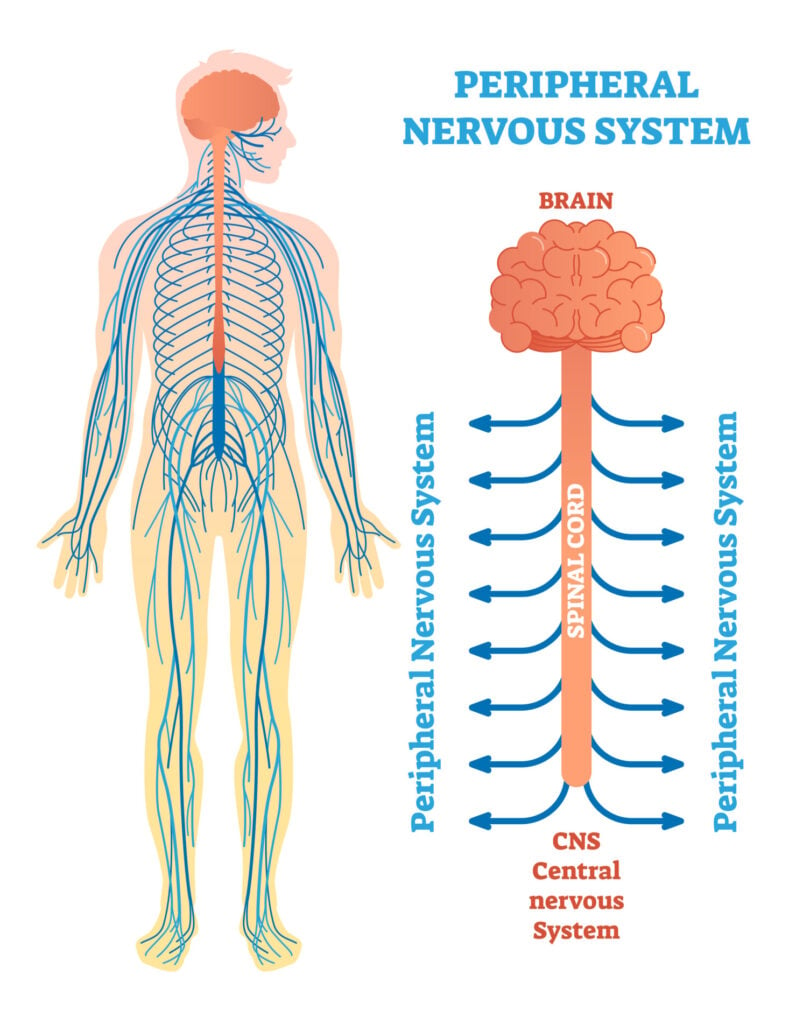On This Page:
The PNS is all the nerves that branch out from the CNS components and extend to other body parts – the sense organs, muscles, and glands. The PNS connects the CNS to the rest of the body.
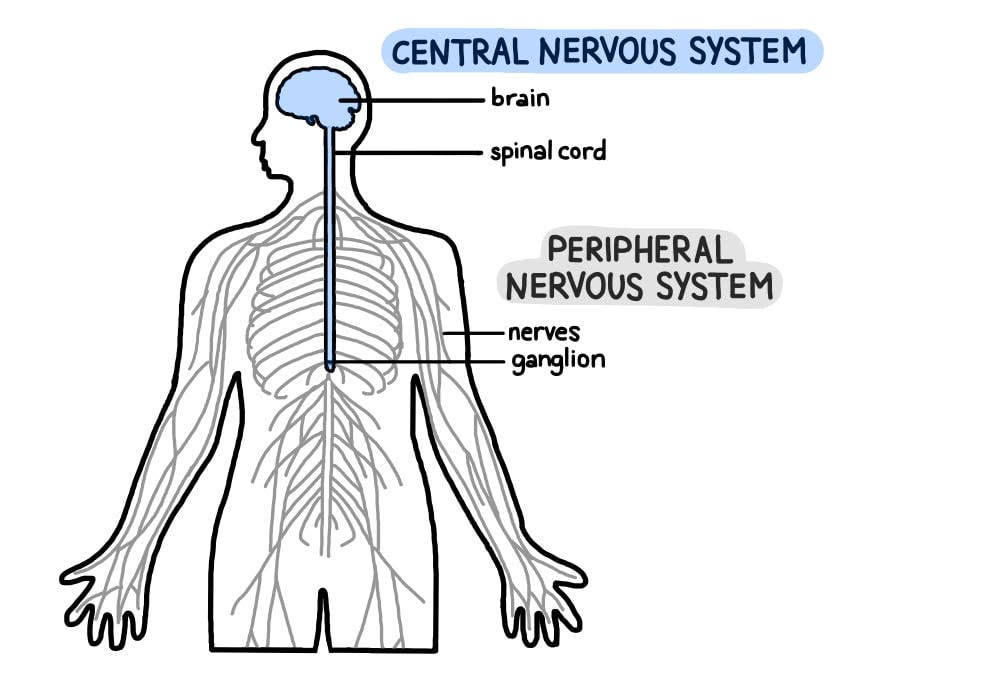
Functions
The primary function of the peripheral nervous system is to connect the brain and spinal cord to the rest of the body and the external environment. The peripheral nervous system transmits information to and from the CNS.
This is accomplished through nerves that carry information from sensory receptors in the eyes, ears, skin, nose, and tongue, as well as stretch receptors and nociceptors in muscles, glands, and other internal organs.
The sense organs can detect changes in the environment and relay information through the sensory nerves to the CNS. The brain can then send signals through the nerves to the muscles, resulting in the muscles moving in response.
Therefore, there is always a stream of incoming and outgoing information between the PNS, CNS, and the body through the form of nerve impulses.
The main functions of the PNS are voluntary movements such as chewing food, walking, and facial expressions. The PNS also regulates autonomic functions such as breathing, heart rate, and digesting – the unconscious bodily behaviors.
The PNS is thus especially important for humans to survive. Unlike the CNS, protected by the skull and the spine vertebrae, the nerves and cells of the PNS are not enclosed by bones. This makes the PNS more susceptible to damage by trauma.
Parts of the PNS
The PNS can be divided into two components: the somatic nervous system and the autonomic nervous system .
The somatic nervous system (SNS) and the autonomic nervous system (ANS) are both parts of the peripheral nervous system. The SNS controls voluntary actions such as walking.
The ANS is responsible for the control of vital functions such as heartbeat and breathing. It is also involved in the acute stress response, where it works with the endocrine system to prepare the body to fight or flight.
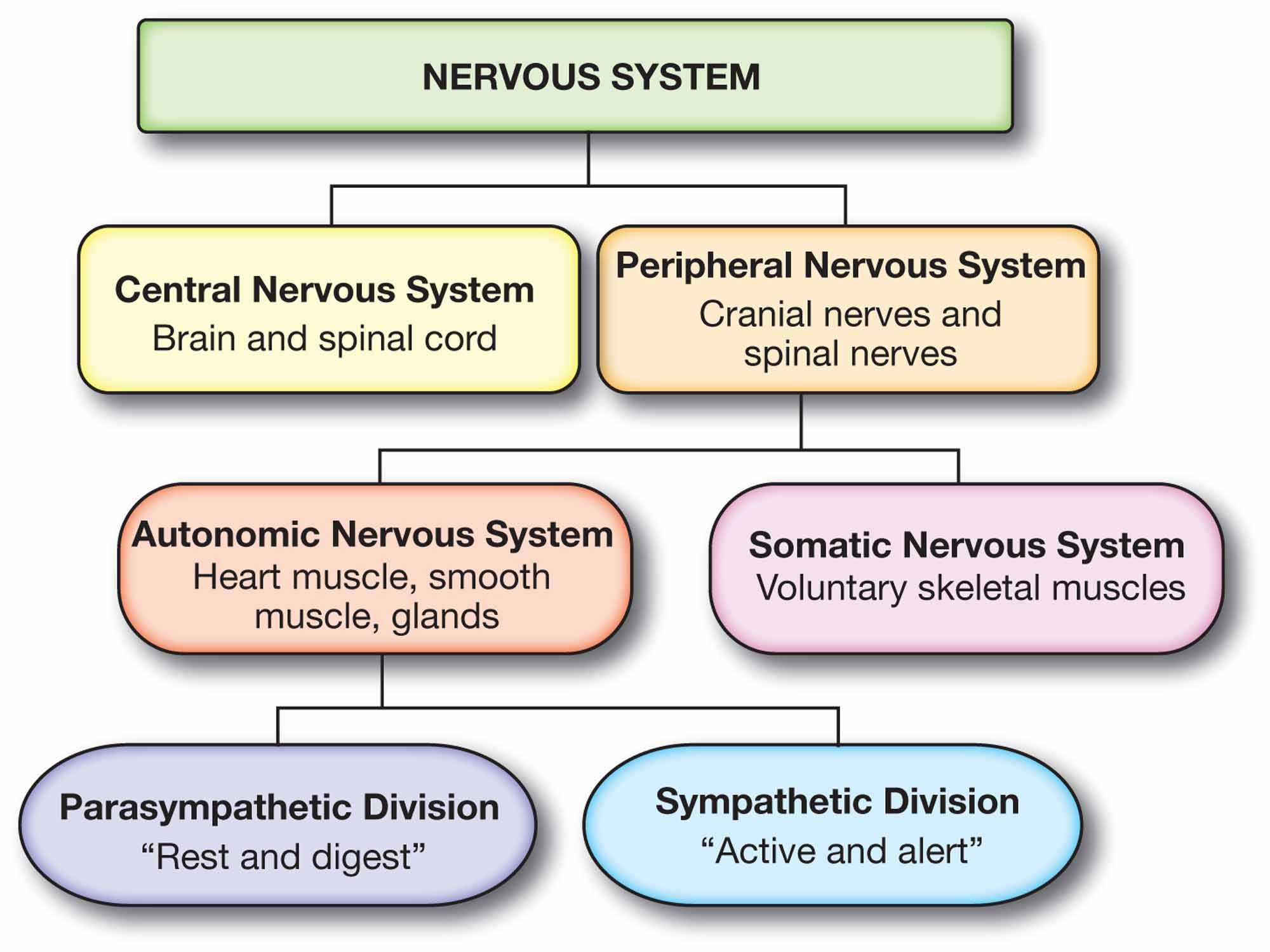
Somatic Nervous System
The somatic nervous system is associated with activities traditionally thought of as conscious or voluntary.
The somatic nervous system is key for carrying messages throughout the body to initiate and control movement. This system processes sensory information from external stimuli (e.g., through hearing, sight, and touch) and motor information, which then carries signals to and from the CNS.
This is so it can interpret sensory information and control voluntary movements.
The somatic nervous system is involved in the relay of sensory and motor information to and from the CNS; therefore,
it consists of motor neurons and sensory neurons.
- Sensory neurons – also known as afferent neurons, send information to the CNS from the internal organs (glands, muscle, and skin) or external stimuli (e.g., through sound, heat, touch, and light). For instance, when touching a rough surface, this information will be transmitted through the sensory neurons to the brain.
- Motor neurons – also known as efferent neurons, transmit signals from the CNS to skeletal and muscle to either directly or indirectly control muscle movements. Motor neurons allow us to act in response to external stimuli. For instance, sensory neurons send this information to the brain while tasting food. The brain will then transmit signals through the motor neurons to encourage the mouth, jaw, and teeth to continue eating the food.
As well as regulating voluntary movements, the somatic nervous system is also responsible for reflexes. This is an involuntary muscle response being controlled by a reflex arc, which is a neural pathway.
For instance, when touching a very hot surface, the sensory neuron activity will be skipped, and instead the brain will send almost instantaneous motor signals to move the hand away from the surface quickly.
Autonomic Nervous System
The autonomic nervous system coordinates involuntary behaviors such as heart rate, breathing, and digestion. This system allows these important functions to take place without conscious thought, so they work automatically.
The autonomic nervous system is further divided into two components:
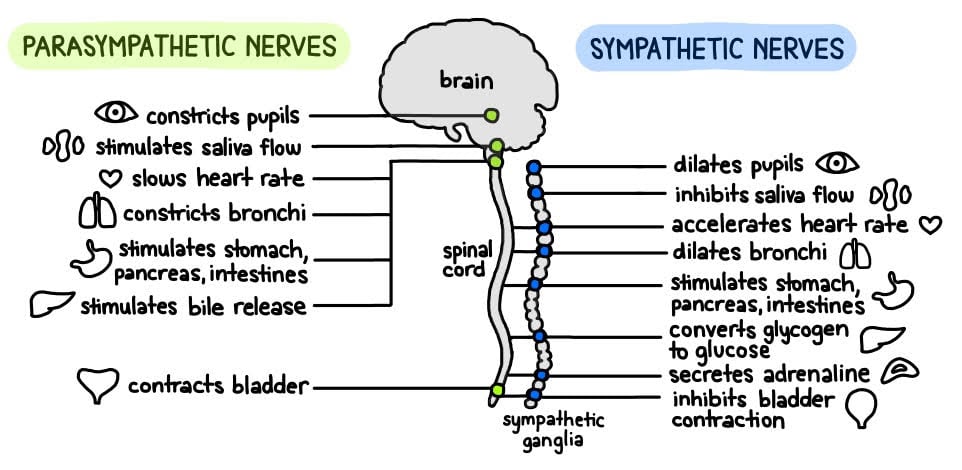
Sympathetic Nervous System
The sympathetic nervous system mostly comes into play when the body needs to respond to threatening stimuli. This response is called the fight-or-flight response.
During a threatening situation, this system will respond by increasing heart rate, activating sweat glands, increasing blood flow, and dilating the pupils.
It slows bodily processes that are less important in emergencies, such as digestion.
Parasympathetic Nervous System
The parasympathetic nervous system relaxes the individual once the emergency has passed. The parasympathetic system aims to maintain normal bodily functions by decreasing activity/maintaining it.
When this happens, the system will reduce the heart rate, stop the body from sweating, decrease blood flow, and constrict the pupils – allowing us to reach a state of rest.
The parasympathetic ANS leads to decreased arousal.
The two systems have complementary functions, operating in
tandem to maintain the body’s homeostasis (a state of equilibrium).
Nerves of the PNS
The peripheral nervous system comprises thick bundles of axons, called nerves, carrying messages back and forth between the CNS and the muscles, organs, and senses in the body’s periphery (i.e., everything outside the CNS).
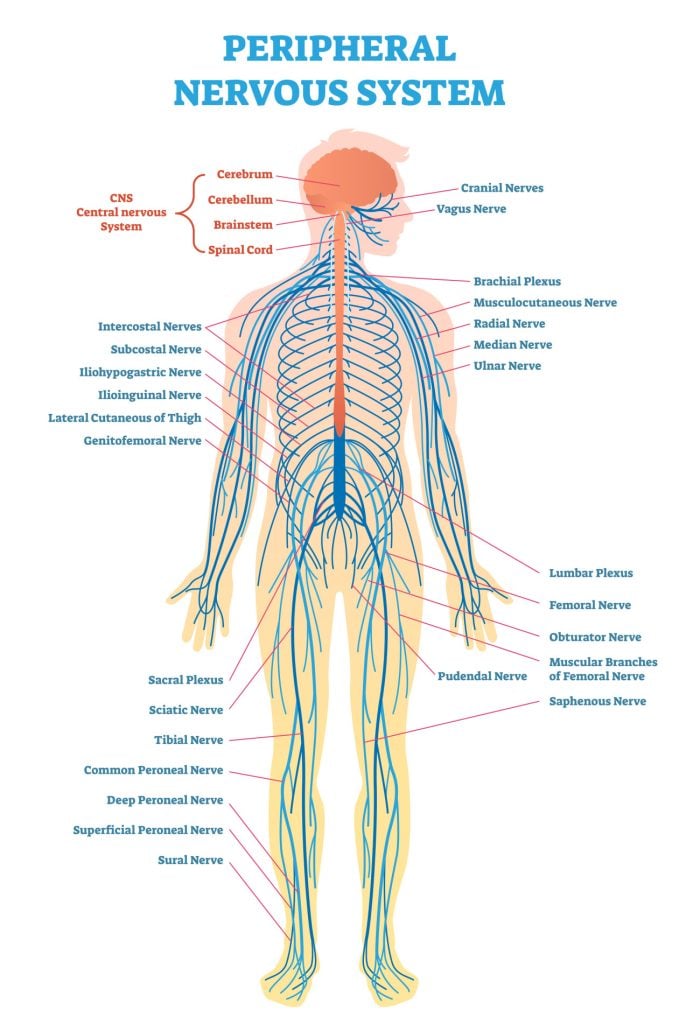
The nerve cells (or neurons) are the information-processing units of the brain that are responsible for sending, receiving, and transmitting signals throughout the body. The neurons are essentially the cells that make up the central nervous system and the peripheral nervous system.
The structure of neurons allows it to receive and carry messages effectively to other neurons and throughout the body. It contains a soma (cell body), which is the core of the neuron, responsible for ensuring that everything is functioning efficiently.
The axon is a tail-like structure of the neuron that functions in carrying signals away from the soma to the end of the neuron for the purpose of transmitting signals to other neurons.
The dendrites of the neurons are tree-root shaped located at the end of the neuron. Their function is to receive and pass on information through their synapses to other neurons nearby.
The nerves are essentially bundles of thousands of individual axons wrapped in a protective membrane in the PNS. Messages are sent along each of the axons to the peripheral organs of the body and send back information to the CNS.
Each axon within the nerve is an extension of an individual neuron.
Within the PNS, there are some nerves that are attached to the spinal cord (spinal nerves) and others which are attached directly to the brain (cranial nerves).
Spinal nerves
Spinal nerves are relatively large nerves that serve the body below the neck, conveying sensory and motor information from the body and carrying messages to the muscles and glands.
The spinal nerves carry signals from receptors around the body to the spinal cord. These signals are then transmitted to the brain for processing.
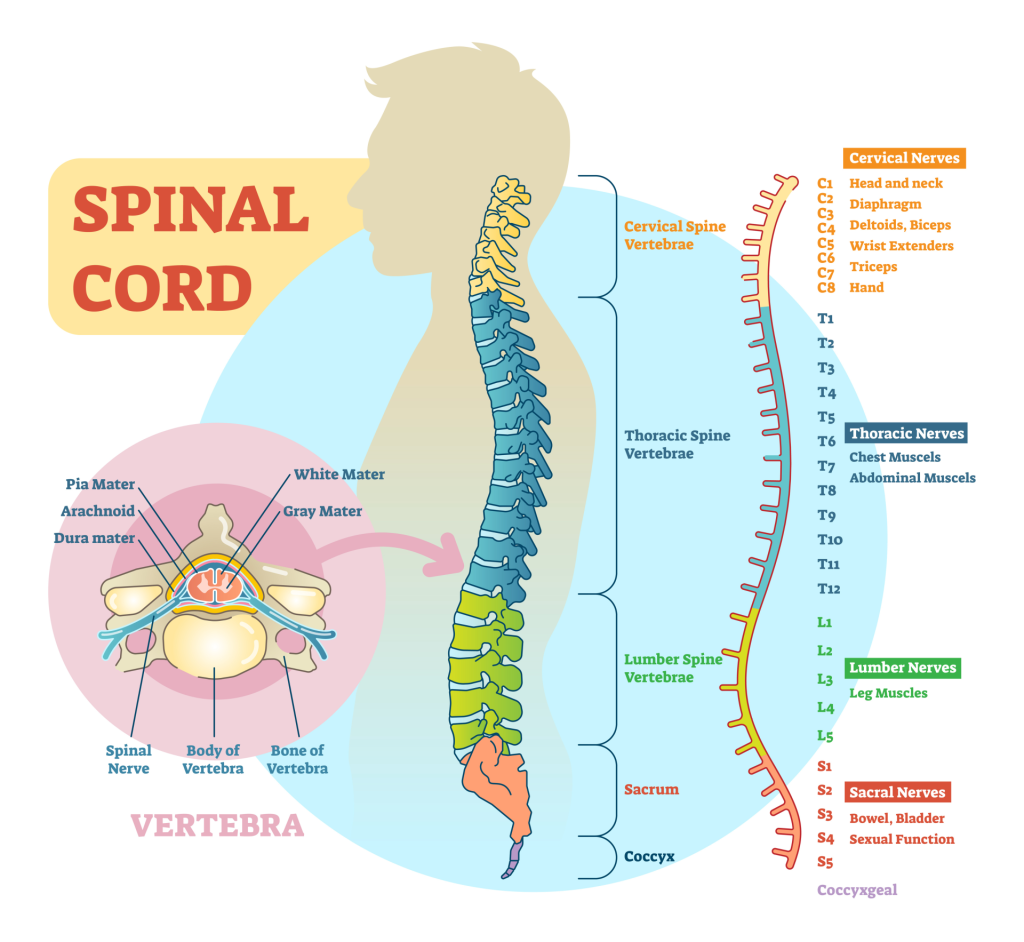
These also transmit motor signals from the brain to the body’s muscles and glands, so the brain’s directions can be carried out quickly.
The PNS is made up of 31 pairs of spinal nerves, which radiate out from the spinal cord, operating different locations of the body:
- 8 cervical nerves, which serve the chest, head, neck, shoulders, arms, and hands (called C1-C8).
- 12 thoracic nerves, which serve the back, abdominal muscles, and intercostal muscles (called T1 – T12).
- 5 lumbar nerves, which serve the lower abdomen, thighs, and legs (called L1-L5).
- 5 sacral nerves, which serve the legs, feet, and genital areas (called S1-S5).
- 1 coccygeal pair of nerves (called Co1).
Each spinal nerve exits the spinal cord by traveling through openings at the right and left sides of the spine’s vertebrae. These nerves divide and subdivide to form a network connecting the spinal cord to every body part.
The longest nerve in the human body, the sciatic nerve (from the lumbar region), networks off until it reaches the tips of the toes, measuring up to a meter or more in length.
Cranial nerves
The cranial nerves primarily coordinate the muscle and sense receptors of the head and neck. These nerves are different from the spinal nerves as they do not enter through the spinal cord to reach the brain, instead, they are directly linked to the brain.
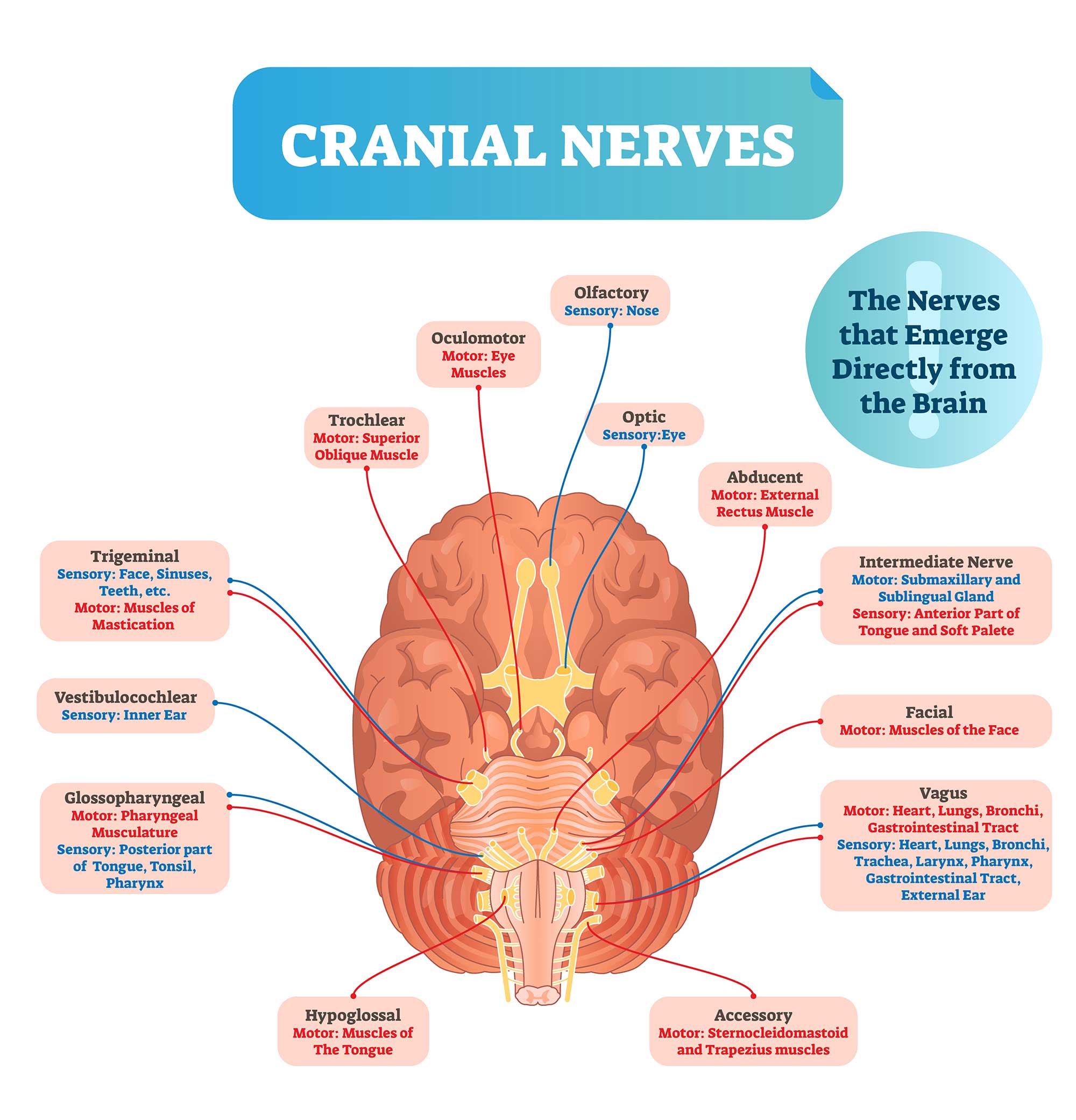
Cranial nerves allow sensory information to transmit from the organs of the brain (ears, eyes, nose, and mouth), as well as conveying motor information from the brain to these organs.
For instance, when eating food, the brain will transmit motor messages through the nerves to move the mouth in order to chew and swallow. When tasting the food, the sensory information gets sent back to the brain through a set of cranial nerves.
There are 12 pairs of cranial nerves attached to the brain:
- Olfactory nerves are sensory nerves related to the sense of smell.
- Optic nerves are sensory nerves related to the sense of sight.
- Oculomotor, trochlear, and abducens nerves are motor nerves responsible for regulating voluntary eye movements.
- Vestibulocochlear nerves are sensory nerves related to the sense of hearing, linked with sound, orientation, and balance.
- Glossopharyngeal and hypoglossal nerves are sensory and motor nerves responsible for tongue muscle movements and sense of taste.
- Vagus nerves are both sensory and motor nerves responsible for movements of the lower head, throat, neck, chest, and abdomen, as well as autonomic functions such as breathing and heart rate.
- Spinal accessory nerves are both sensory and motor nerves responsible for the muscle and movements of the head, neck, and shoulders.
- Facial nerves are sensory and motor nerves related to the taste buds and movements of the face (facial expressions).
- Trigeminal nerves are sensory and motor nerves that carry signals from the eyes, teeth, and face, as well as impulses from the lower jaw and muscles involved with chewing.
Sources
Dorland, W. A. N. (2011). Dorland’s Illustrated Medical Dictionary E-Book. Elsevier Health Sciences.
Eyesenck, M. W. (2012). Simply Psychology. New York: Taylor & Francis.
Goldstein, D. S. (2010). Adrenal responses to stress. Cellular and Molecular Neurobiology, 30 (8), 1433-1440.
Martin, G. N., Carlson, N. R., & Buskist, W. (2009). Psychology, 4th European edition. Harlow: Pearson Education, 723-725.
